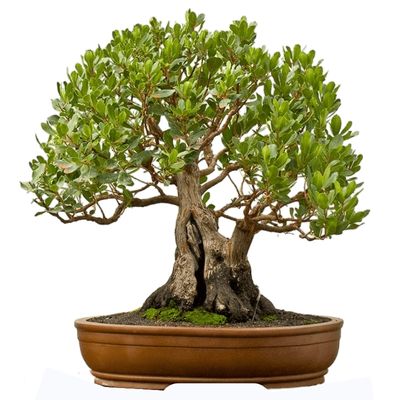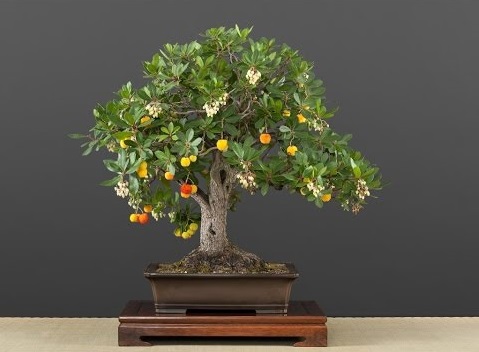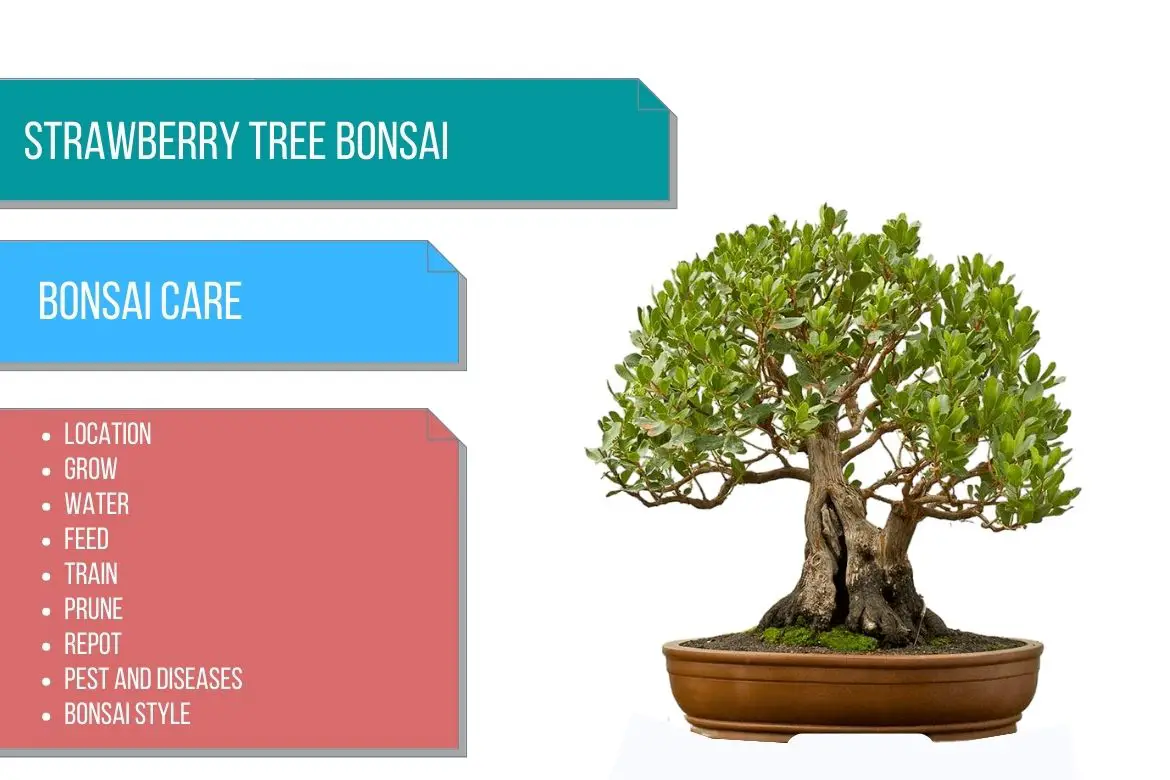
Strawberry tree / Cypress strawberry tree / Killarney Strawberry Tree
(Arbutus unedo)
Country of Origin : Mediterranean
Bonsai Styles : Informal upright, formal upright, broom, twin-trunk, clump
Zone : 7 – 10
Strawberry trees are slow-growing, ornamental evergreens native to the Mediterranean region. They form large bushes or even small trees.
Small white bell-shaped flowers appear in clusters in the fall, followed by red-colored, small strawberry-like fruits no larger than an inch in diameter. This is one of the few trees that can have flowers and fruit simultaneously.

The rough dark brown branches of the tree are covered with dark green glossy oval leaves (almost the size of an oak leaf). The leaves are leathery, smooth, toothed and alternately arranged on the branches.
The tree’s peeling, rust-colored bark makes a striking contrast to its shiny green leaves. It also gains a gnarled appearance as it matures.
Since the strawberry tree has large leaves, it is not suitable for making small bonsai trees. Therefore, even though it makes a great decorative bonsai tree, it is not often grown as a bonsai.
If you are trying to grow a strawberry tree bonsai aim for a minimum height of 20 inches (50 cm).

Read more about other bonsai trees species in : Types of bonsai tree
Best location to keep Strawberry tree bonsai
Strawberry tree bonsai can be kept in partial shade or full sun all year round. It can also be grown as an indoor bonsai tree.
Preferably, you should place the bonsai outdoors during the summer season (for good growth). Protect it from the harsh midday sun in midsummer to prevent leaf scorching.
Temperature range in which it will thrive is between 55°F and 66°F (13°C and 19°C).
Also at the time of flowering (early and late in the growing season), keep the bonsai in a cool, partially shaded location.
You can keep them indoors in a bright window facing south or west (preferably south facing). It will thrive when it receives 5-6 hours of sunlight every day. You might also want to consider grow lights. Please read how to use grow lights for bonsai for more details. It is a great bonsai for patios that does not get too cold in winter.
In the winter, the bonsai should be kept cool in an unheated room. It’s a hardy tree and when grown in the ground, it can tolerate freezing temperatures. However, when grown as a bonsai, protect it from frost.
It will tolerate very short periods of freezing temperatures, but it will stop it from fruiting. Also, do not place the bonsai in a place with high humidity.
When the bonsai is flowering, protect it from rain and never expose it to cold winds.
IMP: Refer to do bonsai trees need sunlight for more indoor and outdoor bonsai location ideas. Also, refer sunlight requirements for indoor plants for more indoor gardening ideas.
Propagation of Strawberry tree bonsai
Strawberry tree can be propagated through cuttings and seeds.
While using seeds, keep them in a plastic bag filled with moss and place them in refrigerator for 90 days. This cold stratification is needed to trigger germination. Sow the seeds in a cold frame. Seeds will germinate in about 90 days.
While using cuttings, take softwood cuttings in midsummer. Plant them in an equal mix of peat and sand. Maintain a temperature of 60°F and 64°F (16°C and 18°C). In almost a month, you should see rooting.
Watering Strawberry tree bonsai
The plant can tolerate brief periods of drought. Water the bonsai moderately throughout the growing season. You can use tap water as the tree is lime tolerant.
Water this bonsai when the soil feels dry to the touch. When watered less, the leaves will also loose their typical stiffness.
Keep the soil a little dry in winter but do not let it dry out completely.
Read watering bonsai tree (for immersion technique) and indoor bonsai tree care for more details.
Wiring Strawberry tree bonsai
The natural growth habit of this tree makes it suitable for broom and upright bonsai styles. In order to train this tree in other styles, training must be started very early or by chance the trunk has started growing in a different direction.
Arbutus unedo bonsai can be wired in the spring and early summer. Wire the branches carefully as the bark of the tree is very delicate.
Branches that are one-two years old can be wired without leaving visible marks on their bark. Remove all wires before winter.
It is not advisable to wire older branches as they tend to be quite brittle and inflexible. However, if you are still trying to wire them, consider carefully guying them down with suspended wiring.
Read : Detailed guide on How to wire a bonsai. This extensive guide includes all the wiring techniques and Do’s and Dont’s. It will also show you other bonsai training techniques which can be achieved without using wires.
Pruning Strawberry tree bonsai
When to prune Strawberry tree bonsai?
How to prune Strawberry tree bonsai?
The tree can be pruned anytime during the growing season. Shorten the new shoots back to 2-3 leaves once the shoot is almost 8 inches long. In the crown area, prune the shoots back to one leaf if the distance between the leaves is wide.
Large pruning wounds on this tree must be sealed with a sealant immediately. This will help in quick healing of the wound.
This tree can also produce shoots or suckers from the lower part of the trunk. Remove them as soon as they appear.
Read how to prune a bonsai to know about the right technique of pruning and more about defoliating a bonsai tree.
Repotting Strawberry tree bonsai
When to repot Strawberry tree bonsai?
Strawberry tree bonsai can be repotted every 2-3 years in the spring.
Prune all the flowers and fruits at the time of repotting. If you are going to perform extensive root pruning, defoliate the tree completely.
If feeding is done properly, established bonsai trees will survive in the same soil for a long period of time. So no need to change the soil in that case.
Use a free-draining bonsai soil mix.
You can also make a bonsai soil mix by mixing loam, sand and peat moss (2:2:1). You can also mix compost, fired clay particles and sand in the ratio 1:3:2.
Please check out how to repot a bonsai to know everything about repotting and root pruning a bonsai.
Must Read: Bonsai Soil Recipes
Feeding Strawberry tree bonsai
They can even survive without fertilizer but the growth of the tree will be slower.
You can apply a weak organic fertilizer every 4 weeks during the growth season.
Do not feed the bonsai when the temperature drops below 53°F (12°C) in winter. When kept indoors in an unheated room during the winter, the plant can be fed every 6 weeks.
Read more about bonsai fertilizer and its application. This will also give you more details on how to feed flowering bonsai trees.
Diseases and pest of Strawberry tree bonsai
Strawberry bonsai trees are not particularly susceptible to pests.
However, they can occasionally attract whiteflies, aphids, scale insects and caterpillars.
Please make sure you read our comprehensive guide: How to identify and treat bonsai pests and diseases is a great resource for you to see all the organic and inorganic remedies you can use.

